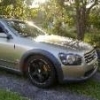M35 Info
Announcements
-
Similar Content
-
Latest Posts
-
My son saw this Porsche 904 in Yodoyabashi in Osaka, not sure if it's the plastic or fibreglass version 767605763.559358.mp4
-
By drifter17a · Posted
I agree re not trusting it as it makes mistakes however can do hours of research for you at times by simply asking a question -
By drifter17a · Posted
The I've done a lot of research and feel like I'm becoming a nut and washer expert. The washer in question doesn’t look very conical—it’s almost flat, but one side has a chamfer. The guide's picture shows the convex side (chamfered side) facing the nut, but the text says the chamfer should face the pulley, which is confusing. If I follow the picture, the chamfer faces the nut, but the instructions say the opposite. When I place the washer on a flat surface, one side looks flatter—maybe that's the concave side—so I would expect the chamfer to be on that side. But it isn’t, which adds to the confusion. The term chamfer is also throwing me off. I always thought the concave side should face the pulley, and the convex side (with the chamfer) should face the nut or bolt head. But Nissan’s instructions say the chamfer should face the pulley, which seems backward. I know I’m probably overthinking it, but I want to be sure I’m doing it right. Also, I’ve seen some people replace the nut and stud with a bolt, but I assume that’s not a good idea, since it might not keep proper tension on the tensioner. Lastly, just to be 100% sure: the pressure washer should face the pulley, then the conical washer? That feels strange, since usually the pressure washer goes first, facing the bolt or nut. -
I checked, i dont think it was the indicator stalk. The problem just magically fixed itself though.
-
H1 is not the Humvee, but is the most road based version. Lachlan (HankScorpio) on here has a proper Humvee. He imported it a few years back.
-





Recommended Posts
Create an account or sign in to comment
You need to be a member in order to leave a comment
Create an account
Sign up for a new account in our community. It's easy!
Register a new accountSign in
Already have an account? Sign in here.
Sign In Now